Finance & The Economy (2004-09)
(Newer postings about finance and the economy can be found here .)
 Flatlining: Former Wall Streeter and financial analyst Bruce Krasting has written, "I was talking to a friend who is a contractor. He's been in business for a long time and has a good reputation. Renovations, additions, a custom built house now and then were his specialty. In the good times he had three crews working full time and a payroll of $20 grand a week. The good times are over. I asked him how is business was going. His response, 'It stinks.'" Flatlining: Former Wall Streeter and financial analyst Bruce Krasting has written, "I was talking to a friend who is a contractor. He's been in business for a long time and has a good reputation. Renovations, additions, a custom built house now and then were his specialty. In the good times he had three crews working full time and a payroll of $20 grand a week. The good times are over. I asked him how is business was going. His response, 'It stinks.'"
There's a lot more to Bruce's article as he goes from a micro to a macro look at the U.S. economy. He forecasts that "the economic recovery for the next few years will be anemic at best."
His story hit home with me. Literally. In the past seven years, we've spent almost $160,000 in major home repairs and improvements. (None were financed.) We felt that it was money well spent, making our domicile more pleasant and/or making it easier to sell someday.
In 2009, we've spent nothing. And have no plans to do so in 2010 either. Yes, there are additional improvements we'd like to make to our 28 year-old house but, given the nonexistent investment performance of the past 10 years (Dow-Jones 11/26/1999: 10,998; Dow-Jones 11/27/2009: 10,310) and the uncertainty of the foreseeable future (extreme government deficits, battered dollar, a probable return to high inflation and a busted monetary policy), we're hanging on to every nickel we can.
Don't expect us to jump-start the left-for-dead U.S. economy. (posted 12/4/2009, permalink)
Danger! Danger! The commercial real estate market is continuing to tank; this has very serious implications for the U.S. economy.
John Carney has written, "In a pattern familiar from the housing crisis, the value of commercial real estate has been plunging while the volume of distressed commercial real-estate loans is rapidly rising. The problems in commercial real estate could slam financial institutions, especially smaller regional and community banks, with billions of dollars in new losses. That, in turn, could snuff out whatever chances we have of a sustained economic recovery."
Commercial real estate prices have fallen 33% this year and 45% from their peak. Depending on whom you ask, 55-66% of commercial mortgages are underwater. About half of all commercial mortgages sit on the balance sheets of smaller banks; the massive number of bank failures this year is significantly attributable to losses from commercial real estate.
How did this happen? Carney has noted, "In 1980, Congress passed the Depository Institutions Deregulation and Monetary Control Act and in 1982 the Garn–St. Germain Depository Institutions Act. The combined effect of these was to allow banks small and large to enter into real estate lending big time, especially commercial real estate lending. Real estate quickly came to account for 50 to 60% of most banks portfolios.
The new availability of financing for commercial real estate triggered a construction boom and sent prices of existing commercial real estate skyrocketing."
During the savings & loan crisis and real estate bust of the late 1980s, the Resolution Trust Corporation went to Wall Street to find a way to sell its many loans. "The result was the invention of commercial mortgage-backed securities (CMBS). By packaging the loans into securities, the RTC was able to sell off thousands of loans in a single transaction - something that would have been impractical if they tried to sell the loans one at a time."
Within 15 years, CMBS grew to a huge, $550 billion market as banks, pension funds and endowments all became major buyers of commercial real estate. Bank regulators allowed banks owning CMBS to deploy far more capital in the market that they could have otherwise, instead of requiring conservative asset valuations.
If you wanted to finance a new zinc die casting machine for your manufacturing plant, your bank would value it very low because 1.) The bank isn't familiar with the used die casting equipment market and will therefore assign it a low liquidation auction value and 2.) The bank doesn't know the volatility of this limited market.
In reality, securitized real estate may be just as volatile and mysterious as die casting machinery, but many banks took comfort from seeing big Wall Street names behind the securities and tacit government approval. Eventually, 60% of commercial mortgages were securitized.
Meanwhile, Alan Greenspan and his cronies at the Fed lowered rates and kept them low. This created an illusion of prosperity that led many business managers/owners to conclude they needed new stores, new plants and new offices. Banks were only too happy to accommodate them.
Investors, banks and regulators came to believe that commercial real estate and the mortgages supporting them were safe. The risk no one appreciated was the risk that we weren't as wealthy as a country as we thought and that a slowing economy could mean that the demand for commercial real estate could shrink so fast and so far.
As many as 65% of commercial mortgages maturing over the next few years will not be able to qualify for refinancing because of the drop in the value of the underlying property along with stricter underwriting standards from nervous banks. Unable to qualify for new financing when their current mortgage is up, the property owners will find themselves unable to pay the end of term balloon payment and be forced to default.
Carney concluded, "The value of commercial real estate has dropped, regulators are reacting slowly, banks are pretending troubled loan portfolios are healthy, people are assuming this is a temporary dislocation, and new credit is hard to come by. This could destroy whatever chances we have of a sustained economic recovery." (posted 12/2/2009, permalink)
Jobless Recovery: I hate to use the 'R*cov*ry' word, because so far there is no sign of one. I suppose that the U.S. economy will recover in time; it always has in the past. But the numbers look disturbing.
In past recessions - before 1990 - the time from pre-recession job peak to full job recovery was 18-24 months. In 1990, it took over 30 months. The next recession - 2001 - required over 46 months. The present recession may not have hit peak unemployment yet and it is already 22 months long, suggesting that a complete employment recovery cycle may be in excess of four years.
Note that the time to recover from job losses keeps getting longer and longer. I would suggest three causes for this: 1. The proliferation of outsourcing, 2. Elimination of customer services, 3. Job consolidation due to mergers, buyouts and right-sizing.
Furthermore, economist David Rosenberg, formerly of Merrill Lynch, thinks the unemployment rate will rise to at least 12 percent, maybe even 13 percent. Optimists, Rosenberg explains, "underestimate the incredible damage done to the labor market during this downturn. And even before this downturn, the economy was not generating jobs in huge numbers."
James Pethokoukis has provided 12 reasons why unemployment is going to top 12%.
If that happens, you can expect a rout of the Democrats in 2010. (posted 11/13/2009, permalink)
Scary Times: The big paper mill in Albany, OR - just up the road from where my plastics manufacturing business was once located - is closing down forever. The remaining 230 employees will be terminated in December. The fate of the 900-acre mill site itself is unknown. The owner, International Paper, is also permanently closing its paper mill in Franklin, VA and its container-board mill in Pineville, LA.
The Albany facility, which opened in 1955 and was originally owned by Western Kraft, is closing because of a steep decline in the container board industry, namely cardboard box materials. Much of the cardboard used by American producers is now made outside the U.S.

Much of America's exported product is waste paper - shipped to Asia to be converted to cardboard boxes for manufactured goods for export back to the United States. America's largest exporter, in terms of volume via container, is American Chung Nam, Inc. In a year, the Chinese company typically exports over 200,000 containers of waste paper to its Chinese sister company, Nine Dragons Paper Industries.
When manufacturing disappears from America (thanks to OSHA, tort lawyers, intractable unions, an anti-business climate and a myriad of silly and confusing rules and regulations - ones not found overseas), many supporting industries - like packaging suppliers - disappear with it. Just ask the residents of Albany.
Another venerable company, Studer's Floor Covering of Vancouver, WA, is closing. It had been in business since 1960 and employed 33. Studer's annual business sales peaked at $8.2 million at the height of the home-building boom in 2005. 2009 sales will barely top $2 million.
In addition to residential new construction, Studer's also serviced the remodeling and commercial markets. That diversified strategy kept the company afloat during prior recessions. "It got us through the '80s and every other downturn, but this time it has hit us on all three fronts," said owner Scott Studer.
There's a lot of blame to go around here, starting with government interference in the residential housing market during Clinton years. And continuing.
It ended up being one of the major causes of last year's financial crisis. Today, instead of taking in savings deposits and loaning that money out to individuals and small businesses, banks are buying U.S. government debt in an effort to shore up their balance sheets - which are full of upside-down residential and commercial real estate loans and "underperforming assets" - deadbeat loans - which have yet to be written off. (No mark-to-market here, just mark-to-myth.) They're paying for the sins of the past. Making the rest of us suffer, too.
Lending to small business, the real engine of job creation, has decreased each month since the meltdown. So, there's no money available to carry a firm such as Studer's through this economic downturn.
Experts say we need a business-spending recovery from this severe recession. But where are we going to get business-investment spending when banks aren't lending?
I worry about my America.
So does Bill Bonner, of the Daily Reckoning, who has written, "America was the world's leading nation in the '50s and '60s. And it was growing in power and wealth - rapidly. We grew up with it. Things were getting better and better … we were sure we'd live much grander, richer and more exciting lives than our parents. The sky was always the limit."
"Now, America is in decline. China's economy grows while hers declines. The Far East has savings, while she has none. The Asia nations are net exporters, making huge profits ... while American industries are judged too old, too expensive, and too highly regulated to compete. Americans have debt up the kazoo, while their competitors have little. A young person in America has to look forward to supporting 70 million retired baby boomers ... and paying for their drugs, their food, their wars, and their bailouts." (posted 10/28/2009, permalink)
Actions Have Consequences: Here's a scary graph, from Barry Ritholtz:
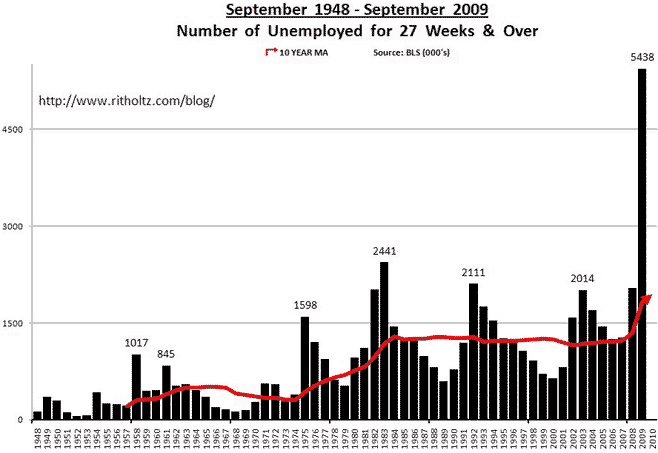
This is what happens when you run your banking system like a dysfunctional three-card monte game, outsource all your subassemblies to Asia, close plants in Indiana and Michigan and move production to Mexico, close the tech support center in California and open one in Bangladore - and vote for a government whose policies make the aforementioned business actions seem sensible. (posted 10/9/2009, permalink)
The Recession Continues: September 2009 consumer bankruptcy filings reached 124,790 - a 41% increase over last year. "Bankruptcy filings continue to climb as consumers look to shelter themselves from the effects of rising unemployment rates and housing debt," said American Bankruptcy Institute Executive Director Samuel J. Gerdano. "The consumer filing total through the first nine months is consistent with our expectation that consumer bankruptcies will top 1.4 million in 2009." Ouch.
But ... but ... but government economic experts predicted that good times would return once the Stimulus Package, Bank Bailouts and Cash for Clunkers kicked in. Didn't they?
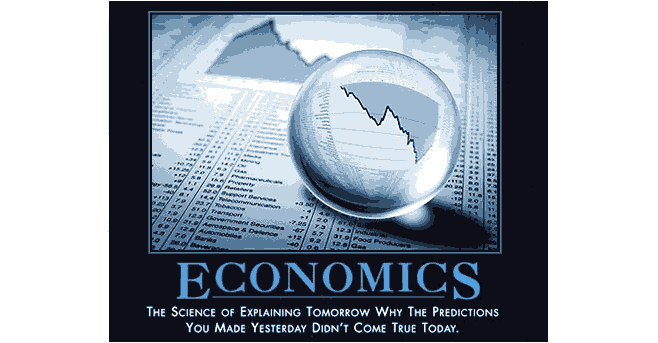
Ylan Q. Mui of the Washington Post has written, "The fragile economic recovery has relied heavily on government stimulus spending, but new data show that as the money runs out, a sustained rebound may be elusive."
Too many people are out of work and jobs are scarce. The unemployed and underemployed - 25-plus million people - will not going to malls for trinkets, treating the kids to the latest movie at the multiplex, taking trips to Disneyland, dining at posh, soigné eateries, upgrading to Windows 7 or buying nifty, expensive Christmas gifts.
The recovery from this trashed and thrashed economy is going to be verrrrry slooowww. (posted 10/5/2009, permalink)
Bloodletting: Phlebotomy is one of the oldest medical practices, dating back to the times of the Mesopotamians and the Egyptians. The withdrawal of sufficient blood as to induce fainting was considered beneficial. It also stifled the cries and complaints of the patient.
In recent times, the government has been engaging in gross phlebotomy on America's small businesses. Last month, Glenn Beck hosted a special titled 'The Death Of Small Business'. He began, "We're holding a funeral of sorts for the small businesses in America that are dying - and the government has their blood on its hands." He cited these points:
|
• "The Obama administration and Congress are forcing socialized medicine down our throats."
• "They're forcing unions to take over your successful businesses and hijacking the contracts of workers under the interestingly worded employee 'Free Choice Act'."
• "They're raising your capital gains taxes and, when that frightening cap-and-trade bill passes, energy prices are going to skyrocket so much that there is no way your small business is going to be able to afford to pay the utility bills."
|
Beck's audience was a diverse group of forty or so small business owners, including restaurateurs, a sheet metal fabricator, an instrument manufacturer and the CEO of Overstock.com. They contributed their thoughts and gave specific examples of government hindrance.
It was pointed out that the government has bailed out failed big businesses like General Motors, Chrysler, Citi and AIG but does nothing positive for successful small businesses even though small businesses are the engines of growth for this country. Depending on which study you choose to cite, 60 to 70% of all net new jobs in the U.S. come from small businesses. (This makes sense: every day, you read about big companies shedding U.S. jobs, either eliminating them or moving them offshore.)
Yet, the stimulus bill had more money for the Endowment for the Arts than for small businesses. Instead, small business owners get burdened with the nearly-useless SBA (read more about that here). Beck's audience noted that banks have money but are not lending it; they have raised lending standards through the roof.
Treasury Secretary Tim Geithner got caught in another lie when he claimed that banks are constantly increasing lending to consumers. Banks, and not just any banks, but those receiving government bail outs and subsidies, continued to constrict lending in July, with total average loan balance outstanding declining by 1.3%, following a 1.1% decline in June.
Loan originations in July declined a whopping 10% after posting a 12.7% increase in June. And the SBA is not backing those small business loans they had promised to back.
Tax increases, both direct and indirect (such as the proposed 8+% health care tax on every small business), were cited as stifling expansion. This is nothing short of hemorrhaging of potential investment capital; there's no money to expand the business if you're paying all of it in taxes. Taxes is especially burdensome for firms using a pass-through corporate form such as an S Corp. Cap & trade - if enacted - would become an indirect tax nightmare, bleeding money from the bottom line on the P&L statement. The pro-union card check proposal would add still another burden to the back of small business.
The annual cost of mandated Federal regulations for firms with less than 20 employees is estimated at almost $8,000. This does not include the cost of training poorly-educated, near illiterate graduates - products of our failing unionized education system, which turns out near-illiterate slackers with little knowledge and even less work ethic.
This is not new, of course. The shocking decline in education was apparent when I owned a manufacturing company many years ago. Here's a 1988 resignation notice from one of our marginal (on the soon-to-be-fired list) employees - a high school graduate - addressed to our plant superintendent:

Don't even get me started on the cost of litigation insurance: product liability, employee negligence, etc.
Meanwhile, fat elitist Michael Moore has said, "It's time to put a stake in the heart of capitalism."
Gee, then where will people get the money to see his crappy movies?
'Stake in the heart' is a vampire allusion. Yet it is Big Intrusive Government - the very one supported by Moore - which is sucking the blood from America's entrepreneurs.
Let's stop trying to kill small business. The human circulatory system is - literally - the lifeblood of the body. Small business is the lifeblood of America. (posted 9/18/2009, permalink)
Economics 102: Here's the crux of the problem - a vicious cycle, illustrated by House of Eratosthenes:
Nothing Special: Every time I read an disappointing earnings report, there's always an excuse, usually under the heading "special charges."
Ah, those damn special charges. This is typical accounting crappola that troubled big public companies try to get away with - fooling only the dumbest stockholders, a surprising number of televised talking heads and the most superficial analysts, but certainly not a well-run bank.
Life is full of special charges. So is business.
 If you own a business, you know that unexpected stuff happens. Markets shift, obsoleting inventory, which - surprise! - must be written-off to zero. Machinery breaks and can't be fixed; an expensive replacement must suddenly be purchased. New competition-driven product/service offerings require that all company literature be redone - an unanticipated and costly proposition. These are a unusual events. But such events keep happening. If you own a business, you know that unexpected stuff happens. Markets shift, obsoleting inventory, which - surprise! - must be written-off to zero. Machinery breaks and can't be fixed; an expensive replacement must suddenly be purchased. New competition-driven product/service offerings require that all company literature be redone - an unanticipated and costly proposition. These are a unusual events. But such events keep happening.
As Roseanne Roseannadanna used to say, "It's always something."
If, as a small business owner, you went to your bank and attempted to get a loan by showing financial statements sans those 'special charges', the loan officers would laugh you right out of the ornate marble lobby.
Good bank managers understand the wisdom of Ms. Roseannadanna. To them, special charges include only those incidents involving a hearse, ambulance, fire truck or multiple police cars with flashing lights. (posted 6/19/2009, permalink)
Costly Transfers: Dennis Cauchon of USA Today has written: "The recession is driving the safety net of government benefits to a historic high, as one of every six dollars of Americans' income is now coming in the form of a federal or state check or voucher."
"Benefits, such as Social Security, food stamps, unemployment insurance and health care, accounted for 16.2% of personal income in the first quarter of 2009, the Bureau of Economic Analysis reports. That's the highest percentage since the government began compiling records in 1929."
In 1959, total government transfers were only 6.5%. This percentage began to rise as Lyndon Johnson's Great Society kicked in. After peaking in the mid-1970s, it stayed relatively flat percentage-wise until several years ago, when social spending soared to pay for the Medicare drug benefit, expanded health care for children and greater use of food stamps.
Economist Donald Marron has developed charts, dividing these government transfers into three categories:
|
• The Unemployment Benefits category grows and contracts depending on the state of the economy but has remained relatively flat over the last 50 years.
• The Social Security and Health Insurance segment has grown most rapidly over the last few decades, In 1959, it was 2.5% of personal income. By April 2009, it had grown to 9.5% - almost triple.
• The Other Transfers category includes food stamps, welfare and other social payment programs. In 1959, these transfers represented 2.5% of personal income. By April 2009, the percentage had grown to 6.5%.
|
These kinds of increases are unsustainable and will ultimately cause the economy to collapse. During its short tenure so far, the Obama Administration has only made things worse. Adam Lerrick, economist at the conservative American Enterprise Institute, says the benefits' explosion will eventually lead to an economic crisis.
"We've seen this movie before in many countries. It always has the same ending." Indeed ... a bad one. (posted 6/17/2009, permalink)
So How's That Workin' Out For Ya? A few months ago, the Obama Team warned America that without the Stimulus Package, TARP, Shovel Ready and its assorted other schemes, the economy would be in deep do-do. They even drew a graph showing expected unemployment rates with and without the Recovery Plan.
And so, the Recovery Plan was enacted. But the unemployment data isn't matching those lower unemployment forecasts. In fact, they're exceeding the 'worst case' No Plan forecasts.
Saving The Economy: You can't combine big wars and big social programs - you must pick one. If you insist on choosing both, you will pay dearly in less than 10 years. We observed the results of the excesses of the 1960s when Lyndon Johnson's failed and expensive Great Society program was launched just as the cost of the Vietnam War was escalating. The result was the Misery Index of the late 1970s - a number resulting from high inflation combined with a stagnant, high-unemployment economy.
Blame it on both Republican and Democratic administrations from 1965 through 1980. In 1981, Ronald Reagan and Paul Volcker limited spending and cut taxes; we also had a period with no big wars. Things got much better. The Misery Index disappeared from the nation's vocabulary.
Everything changed after 9-11. Suddenly we were fighting two wars - Afghanistan and Iraq - but without a necessary reduction in funded social commitments. Instead of wartime frugality, we witnessed an increase in social programs, labeled 'compassionate conservatism': aid to Africa, the Medicare drug program, No Child Left Behind, etc.
All of these added to the federal deficit. Now, as in the 1970s, we are beginning to pay the price. Inflation is virtually guaranteed to increase as the president and congress continue to spend money we don't have. The economy will stall; the Misery Index is likely to return.
Once again, the blame will be on both Republican and Democratic administrations.
One indicator to watch is the personal savings rate. After falling to below zero during the depths of the Great Depression and jumping to 25% during WW II (you can't buy stuff when it's rationed or unavailable), personal savings gradually grew during the postwar era, stabilizing in the 7 to 10% range during the period from the 1950s to the mid-'80s.
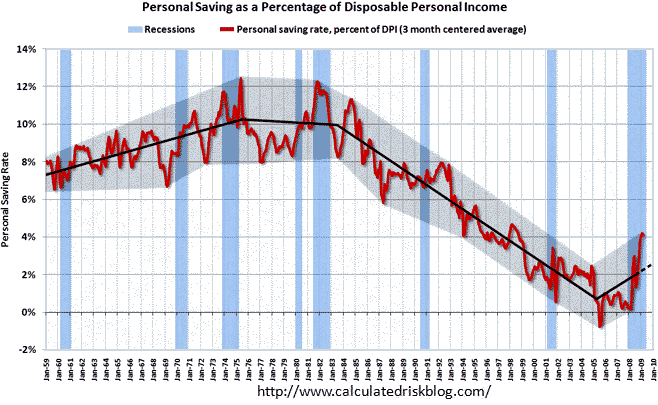
Calculated Risk, a financial/economics blog, has noted: "Some of the change in saving rate was related to demographics. As the large baby boom cohort entered the work force in the mid '70s, the saving rate declined (younger families usually save less), however I expected the saving rate to start to rise as the boomers reached their mid-40s (in the late '90s). This didn't happen."
Over the last 25 years or so, the savings rate has been on a steady decline as people kept bumping up their lifestyle beyond their means - 'luxury' SUVs replacing Ford Tempos and Honda Civics, 4,500 square-foot McMansions with three-car garages replacing 2,300 sq.ft. ranchers with two-car garages, Sub-Zeros replacing 14 cu.ft. Whirlpools, $3,000 stainless steel grills replacing $19 hibachis, mocha grandes replacing a thermos o' joe - these are all manifestations of the underlying disease.
During the first quarter of 2009, the personal savings rate has crawled back up to 4.2%.
Catherine Rampell of the New York Times has written: "This is not because Americans have suddenly become more financially virtuous or have learned the error of their free-spending ways. Instead, these experts say, Americans may have no choice but to continue pinching pennies. ... Over the last 30 years, the savings rate has fluctuated from over 14% in the 1970s to negative 2.7% in 2005, meaning Americans were spending more than they made.
This time is expected to be different, because the forces that enabled and even egged on consumers to save less and spend more - easy credit and skyrocketing asset values - could be permanently altered by the financial crisis that spun the economy into recession. ... But many economists believe consumers will change their habits for more pragmatic reasons.
Consumers have lost a huge chunk of their net worth, in the housing bust and the stock market, and to resuscitate their retirement accounts or children's college funds they will have to channel more of their paychecks toward saving - unless those asset markets soar again.
Forms of easy credit that were once prevalent, like mortgages with no down payments, also may not return, either because the government regulates them out of existence or because banks dare not venture back into such risky lending. That means if Americans want to buy a house, they will have to save more and borrow less."
We can all do our part and put a little more away for a rainy day. But the government needs to exercise fiscal conservatism, too ... before it bankrupts us all. (posted 6/5/2009, permalink)
Crisis In The Making: Manufacturing is vital to the economy of the United States because it is a generator of wealth. By taking low cost raw materials (wood, baking flour, steel) and processing it to produce much more expensive items (furniture, cakes, automobiles) creates profit. This in turn creates wealth - for individuals and for a nation.
Furthermore ... (more >>>)
The Truth About Credit Cards: Here's some insight into the state of the credit card biz these days, posted at The Truth About Cars, no less.
William C. Montgomery has written, "We expect the default rate this year to be about 15% (up from about 6% during normal years). This means that for every dollar we lend, only eight-five cents will get paid back. Plus, it costs us about another 6% to borrow the money, print and mail statements, maintain customer service call centers, etc. In other words, we'd need to be earning 21% in finance charges just to break even. On top of this, new credit card lending rules make it much harder to raise interest rates. In other words, no bank wants to be in the credit card business right now. Just about every bank I know of is looking to unload their credit card receivables so that they can lesson their exposure to the sky high credit losses we are experiencing in the current economy."
A 'default' is any credit card bill which remains unpaid after 180 days. In 2005, the default rate was only 3%.
Today's credit card traces its lineage back to single-merchant charge cards (printed on paper card stock), which were used to promote gas station loyalty in the 1920s, and embossed metal charge plates used by department stores in the 1930s, '40s and '50s. The Diners Club card, developed in 1951, was the first general-purpose charge card which could be used to pay for meals, hotels and merchandise at any number of different establishments. The first plastic credit card was introduced by American Express in 1958.
Even in the late 1960s, credit cards had limited popularity, despite the creation of BankAmericard in 1958 (later renamed Visa) and Master Charge in 1966. (The name was changed to MasterCard in 1979.) In the 1960s and '70s, people over 50 made most purchases with cash. In the mid-1970s, my parents had no national credit cards, just a couple of department store charge cards. They paid for almost everything with cash.
It used to be quite difficult to get a credit card. In the '60s, you needed good, stable employment and a verifiable address history. Limits were low, topping out at a few thousand dollars at best. The idea of "carrying a balance" - not paying a bill within 30 days on a credit card was somewhat scandalous even in the late 1970s. (I must admit that I've never carried a balance on a credit card and didn't even start using a card for gasoline purchases until sometime in the 1990s.)
In the 1980s, everything loosened up quite a bit. 'Footloose' debuted in 1984. Unsolicited credit card offers skyrocketed. Ladies' shoulders were freed up and padded, as were credit applications. Big credit lines trended with big hair. From 1989 to 2004, the percentage of cardholders incurring fees due to late payments of 60 days or more increased from 4.8% to 8.0%.
By the end of 2008, 78% of American households had one or more credit cards. The average outstanding credit card debt for households that have a credit card was $10,679. That's shocking to those of us who grew up in a cash-only environment. (posted 4/28/2009, permalink)
Another Day Older And Deeper In Debt: President Barack Obama has repeatedly claimed that his budget would cut the deficit by half by the end of his term. But as Heritage analyst Brian Riedl has pointed out, given that Obama has already helped quadruple the deficit with his stimulus package, pledging to halve it by 2013 is hardly ambitious. The Washington Post has a great graphic which helps put President Obama's budget deficits in context of President Bush's.
What's driving Obama’s unprecedented massive deficits? Spending.
Yes, President Bush mismanaged the economy - failing to rein in ever-increasing government spending and creating new government programs which further increased the deficit. But Obama and his minions are outrageously abusing the public purse. The stock market remains nervous because of the possible significant increase in the deficit's size and reach, regulation by a runaway government and a certain rise in tax burdens. (posted 4/3/2009, permalink)
Double Bubble: The graph of Individual Wealth Versus Gross Domestic Product (Households and Nonprofit Net Worth as a percent of GDP) calculates net worth by including real estate and financial assets (stocks, bonds, pension reserves, deposits, etc.) net of liabilities (mostly mortgages).
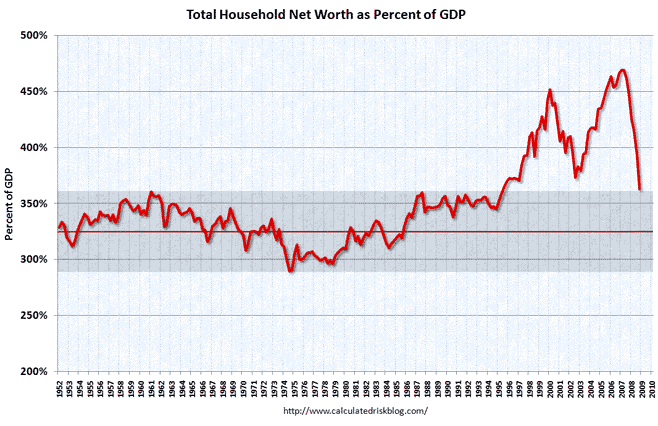
The ratio operated in a narrow range for almost 50 years, then shot up, fell down, climbed again and fell. This is a classic bubble ... kind of. It is actually two bubbles: the tech stock bubble which began in the irrationally exuberant 1990s, bursting in early 2000. And the real estate bubble which began in the mid-'90s and continued through 2006.
The graph indicates that we have not yet completely returned to reality. (posted 3/30/2009, permalink)
Don't Bank On It:  In January 2009, the Bank of Clark County was closed by federal regulators. Ten years earlier, the bank opened for business as a community-based, locally-owned bank. Organizers were initially able to raise $8.6 million from 400 shareholders. In January 2009, the Bank of Clark County was closed by federal regulators. Ten years earlier, the bank opened for business as a community-based, locally-owned bank. Organizers were initially able to raise $8.6 million from 400 shareholders.
The bank grew rapidly and was - for several years - one of the most profitable banks in the Western U.S. It became a prominent construction and real estate development funder in Clark County, Washington. As long as property values kept rising, developers kept building homes, selling them and paying the bank on time. Everybody was happy.
In its quest to compete ... (more >>>)
The Producers: When I was in grade school - in the days when dinosaurs roamed the earth and cars didn't have tailfins yet, one of the subjects we learned was Geography. Much reading and memorization were required. Test questions involved not just physical dimensions: "How large is Ohio?" (Answer: 41,328 square miles) but also what was made there: "What are the chief products of Bolivia?"

In the early 1950s, Bolivia's 412,777 square miles of landlocked, mountainous terrain produced mainly bark, hides, potatoes, cacao, tin and silver. As a third-grader, I didn't fully appreciate the nuances of the goods produced but it was obvious that most of the really backward countries listed sisal and hemp as their chief products. I realized much later in life that perhaps these countries were backward because the populace spent too much smoking all that hemp instead of trying to build a stronger, more prosperous nation.
Even to my elementary school brain, it was apparent that a country must have desirable products which can be sold to other countries in order to become a ... (more >>>)
Formica Banking: The present credit crisis is not unique. Today's debacle is caused by banks overreacting to their excesses of recent years and overtightening their lending practices, much like Elvis' fasts after he gorged on bacon and peanut butter sandwiches.
In the early 1980s, there was a credit crisis as well. People couldn't/wouldn't borrow money ... because it was too expensive. In October, 1981 the national mortgage rate hit 18.45%. Bank loans for cars exceeded 20%. Car and home sales plummeted.
In order to prevent the next credit crisis, banks need to go back to looking and behaving like financial institutions. Once upon a time, banks were built with imposing granite, creating a sense of stability and intimidation. On the other hand, home kitchens were trimmed in Formica.
Today, every overpriced McMansion has granite countertops in the kitchen, while banks appear in strip shopping centers, occupying a 'pad', much like Applebee's, Subway or E-Z Payday Loans. All these Pad Dwellings are trimmed in cheap, cheerful, easy-to-clean Formica.
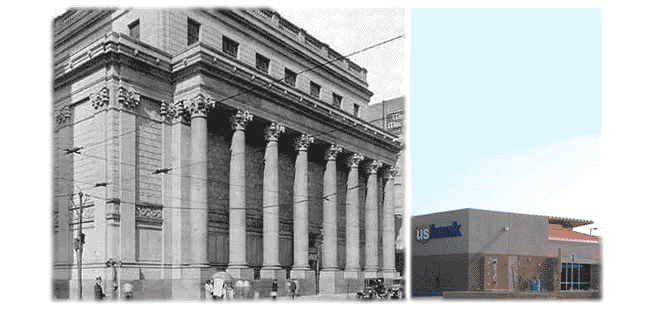
Homes using granite and banks using laminate should have been a tip off that something was fundamentally wrong with the U.S. banking model and the home financing model. But no one noticed it - hindsight is a generally useless commodity - and now we're in a mess.
The meltdown began, in my view, when gas jumped to $4.00/gallon. Financial institutions had loaned mortgage and car money to people who were living on the edge - such a sharp edge that, they had to make a decision between filling the gas tanks of their gas-guzzling trucks to get to work and making loan payments. (Apparently, these borrowers had never heard of bicycles.) The debtors fell off a financial cliff, stopped making loan payments and walked away from "assets" which no one else wanted - and were, therefore, worth less than their loan principal - leaving lenders holding the bag.
The repairing of this mess begins with a return to fundamentals in the loan business. Credit scores - a superficial measuring system at best - need to be subservient to the old Three Cs method: character, creditworthiness and collateral. Character - is the borrower a stand-up guy? Creditworthiness - does the buyer have the income, assets and performance history? Collateral - are there enough assets to secure the debt?
Banks used to operate this way. In the 1990s, banks began to change, getting rid of wizened loan officers in favor of lower-paid suit monkeys who shuffled off all loan requests to a central scoring center for loan approval. In 1992, I asked a Bank of America V.P. of business lending what his personal approval limit was. He replied, "$22,000." He couldn't even approve a used forklift truck loan for one of my manufacturing clients. Today, many large banks give zero personal approval limits for managers - the very people who should know the customers best. On the other hand, these "managers" do know how to clean melamine laminate. (Not hard to learn - a spritz of Formula 409 works well. Why, you could probably train a chimpanzee to do it.)
It's time to fire the Formica monkeys and bring back rock-solid, granite-like banking. With real bankers. (posted 2/13/2009, permalink)
WaMu, The Bank That Couldn't Say No: Steven M. Knobel, a founder of appraisal firm Mitchell, Maxwell & Jackson recalled: "It was the Wild West. If you were alive, they (WaMu) would give you a loan. Actually, I think if you were dead, they would still give you a loan." Except for me. (posted 1/5/2009, permalink)
 Shoulda Looked There Last Year: According to some old papers found in the top drawer of the National Bureau of Economic Research, the U.S. economy has been in a recession since December 2007. Shoulda Looked There Last Year: According to some old papers found in the top drawer of the National Bureau of Economic Research, the U.S. economy has been in a recession since December 2007.
In the same drawer were some old WW II ration books, two 1943 steel pennies, a large pearl-tipped ladies hatpin, a carnival glass candy dish, a red shirt button and the key to a '76 Volkswagen Scirocco. (posted 12/3/2008, permalink)
The Tanking Economy: I'm weary of reading economic forecasts and explanations from 'experts'. Like local TV weather people, their batting average is no better than the Average Joe. Therefore, I'm providing my own predictions; my past track record in advising business clients on the economy has been pretty good.
Let's start with U.S. vehicle sales. It is expected that October's sales will be well under one million units. November will probably be even lower.
Car and light truck sales fluctuate between about 12 and 17.5 million units per year, averaging 15 mm/yr. I expect that 2009 will set a new low, with sales of well under 12 million vehicles. Because of gradually improving conditions and interesting new product offerings already scheduled, I believe that 2010 sales will revert to the 12-15 mm level. It is probable that one or more of the Detroit Three will declare bankruptcy in 2009. Or be restructured and sold off.
Yes, yes, writers will lament the passing of Pontiac, Chrysler or whatever brands get killed off - but, if these scribes loved them so much, why weren't they driving one? America survived without DeSoto, it muddled through the death of Studebaker and it got beyond grieving for Oldsmobile and Plymouth.
The death of Detroit may spell big trouble for Michigan - although given the political corruption, massive layoffs which have already happened, slums, crumbling infrastructure and used car level housing prices in the Detroit area, you have to ask, "How much worse could things get?" Nevertheless, cars will still be made and sold in somewhere the U.S. But the employees probably won't be UAW members and the car badges may be Asian.
As for the rest of the economy, it is time to batten down the hatches. Bad times are already here, thanks to the worldwide credit crisis - even though credit is now easing and interbank funds are flowing again. Donald Luskin, chief investment officer of TrendMacrolytics, has said that the raft of bad corporate news stems from policymakers' initial failures to properly address the financial crisis. There are train cars spilled across the countryside, he said, but the good news is that "the runaway locomotive has been stopped."
We are now in a recession. This one will be deep and longer than those of the past 20 years. I think GDP will drop 8-11% overall and the recession will last three to five quarters. I'd guess that U.S. unemployment will exceed 8%. (In 1974, the GDP dropped six quarters in a row. Unemployment reached close to 9% and in some of the industrial sections of the U.S. that figure was well over 10%.)
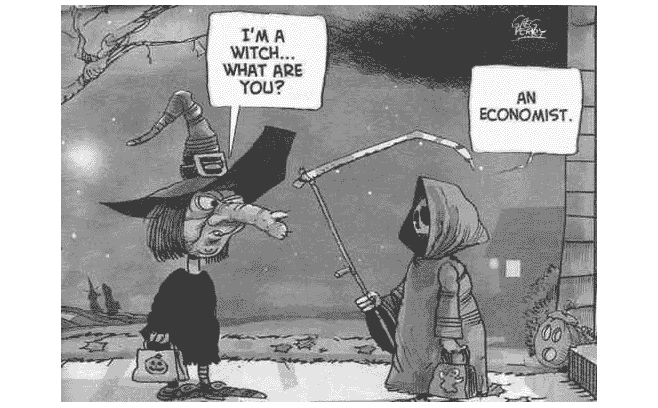
Sales of existing homes have bottomed but will stay flat for another 6-9 months and then begin a slow recovery. New housing starts will remain at pathetic levels for at least another 15-18 months. (This would not be a good time to quit your day job and start a drywall business.) Commercial construction will slow drastically - driven by the inability of property developers to get project funding. This has already begun. Banks have taken a bath in real estate and they're scared.
Dismal sales will make for a bleak Christmas at many retailers. Look for several retail chains to go bankrupt in '09. Doom and gloom will continue into the first quarter, as casual investors get their 401k statements and soil their underwear when they discover how much their net worth has eroded. Consumers will get a second shock when they find banks cutting credit card limits and demanding higher minimum payments.
At that point, a vicious cycle is created. Those out of work can't buy anything. They default on mortgages, car loans and credit cards. More people are laid-off ... and the cycle continues. That's why this recession will linger.
As for the U.S. stock market, it's important to remember that - a year ago - when the Dow was air-kissing 14,000, almost no one was complaining that stocks were overvalued. Price-earnings ratios were well within historical levels; in fact, they were about average. The precipitous drop to the 8-9,000 range means that the U.S. stock market is now bargain basement-priced and very attractive to investors with a long horizon. Yes, corporate earnings will drop as the recession kicks in but they will rise again as the U.S. works its way out of the recession in 2010-11. U.S. equities have fared a lot better than European and Asian stock markets; the Nikkei is at levels not seen since October 1982. (In 1982, the Dow was in the 800 range.)
Don't panic sell. The U.S. stock market will rebound. It always does. Buy-and-hold investors will be happy well before the next Presidential election.
All is not bleak. Crude oil is now below $65 per barrel. Remember when it was topping $147 a few months ago and 'experts' were talking about $8 per gallon gas as oil continued its inevitable march to $200 and above? So much for those forecasting wizards.
A few months ago, know-it-all Europeans were laughing at the puny American dollar, kicking sand in its face. The British pound was over $2.00. It's now in the $1.60 range. The Canadian dollar is now 80¢ or so and the once-mighty Euro has dropped from a buck sixty something to $1.29. Gold is now around $740 per ounce; a few months ago it was over $900.
Dropping oil prices and a stronger dollar will help mitigate the effects of the recession.
We are not going to have a depression. But Americans may finally wise up and realign their purchasing habits to reflect the new economic realities:
|
Pre-Recession
|
|
Coming Real Soon
|
| • Garmin navi system |
|
• paper roadmap |
| • Starbucks |
|
• thermos |
| • new near-luxury vehicle |
|
• car wash & pine tree air freshener |
| • Ruth Chris |
|
• Outback |
| • Roomba |
|
• Swiffer |
| • 60" plasma tv/home theater |
|
• sit closer to old television |
| • Wii console |
|
• charades |
• Laura Ashley
|
|
• Harriet Carter
|
Don't fret too much. America will recover and prosper. We always do. But it will happen a lot faster if Obama isn't at the helm. (posted 10/31/2008, permalink)
Politics, Corruption And Money: Kevin Hassett writes that if one had taken away Fannie and Freddie, or had regulated them more wisely, this whole mess would never have happened.
Back in 2005, Fannie and Freddie were, after years of dominating Washington, on the ropes. They were enmeshed in accounting scandals that led to turnover at the top. In 2004, the Securities and Exchange Commissions chief accountant told disgraced Fannie Mae chief Franklin Raines that Fannie's position on the relevant accounting issue was not even "on the page" of allowable interpretations. In 2005, "a serious Fannie and Freddie reform bill was passed by the Senate Banking Committee. The bill gave a regulator power to crack down, and would have required the companies to eliminate their investments in risky assets." Senator John McCain was one of the three cosponsors of that bill. But the bill didn't become law, for a simple reason: "Democrats opposed it on a party-line vote in the committee, signaling that this would be a partisan issue. Republicans, tied in knots by the tight Democratic opposition, couldn't even get the Senate to vote on the matter."
Many of the senators who "protected Fannie and Freddie, including Barack Obama, Hillary Clinton and Christopher Dodd, have received mind-boggling levels of financial support from them over the years."
PS: The Dems do not like Hassett's article, Kevin reported that "his e-mail and answering machine are getting filled up with howls of indignation and death threats."
Sturm Und Drang: Don't ask me the best way to solve the meltdown but I want any solution to this financial crisis to include televised scenes of heavily armed FBI agents in full riot gear taking axes to the expensive carved wood doors of the executive offices at Fannie Mae and Freddie Mac and dragging everyone inside out of the building in shackles.
I also want Barney Frank, Chris Dodd, Franklin Raines and Jamie Gorelick publicly handcuffed, frogmarched out to a waiting airplane and carted off to Gitmo for some serious interrogation.
And then let's hold public trials and start handing out jail sentences. (posted 9/24/2008, permalink)
Stopping The Merry Go Round: Treasury Secretary Henry Paulson finally said, "Enough is enough" and pulled the plug on the carousel of bailouts. Riders will now suffer dizziness and stagger around but it will pass. The collapse of Lehman Brothers will ultimately be a good thing. It is time for the government to cease propping up large mismanaged firms. On Tuesday, the Fed wisely held its ground and not did lower rates. (After this was written and posted, there were reports of a possible AIG takeover but no details were available.)
Business failure is a necessary outcome of capitalism. For innovation to flourish and progress to be made, the market must be free to reward success and punish failure.
Self-interest, greed, irresponsibility and corruption should not be encouraged. Especially with the government and Congress sprinkling their own self-serving fragrances in the mix. Let's not forget that the Clinton administration, obsessed with multiculturalism, expanded the scope of the Carter-era Community Reinvestment Act, dictating where financial institutions could lend and thereby facilitating the birth of the high-risk subprime loan market. And Congress - Republicans and Democrats - went along, mandating substandard lending to low-income groups. And, as the high-risk loans mounted, the same Congress - under the gun of political contributions - continued to promote the fiscal follies of Fannie Mae, Freddie Mac and their ilk.
When the Fed cut interest rates to 1% in 2003, it created an enormous credit bubble. Leverage-based strategies became so lucrative that many financial market players jumped to leverage up the most leveraged asset on Main Street – housing.
Banks that should have known better made huge loans to people who had insufficient verified income, assets or collateral to purchase houses. (The institutions were later shocked to learn these folks would not repay their obligations. Well, duh!)
Crap mortgage loans were combined and bundled into cleverly decorated packages but - let's face it - they were still sacks of crap. These foil-wrapped stench bombs were marketed by investment houses as fixed income 'investments' which offered better returns than certificates of deposit. I've heard that many were sold to foreign buyers when the dollar was down: "Just think how much you'll make when the dollar goes back up!" Yes, think of it as a large, diversified container of feces with possible upside potential.
Then the housing bubble burst. When the highly-paid CEOs of Fannie Mae and Freddie Mac saw everything falling apart, they ran to their buddies in Congress - Banking Committee Chairman Chris Dodd, Barney Frank, Barack Obama et al. (After all, they had given Obama more than $126,000 in less than four years.) While Fannie and Freddie were running off the rails, Dodd, Obama, Frank and Congress looked elsewhere. That would be the same Barack Obama who, after the stock market dropped 500 points on Monday, made sure his own pockets remained well-lined by hosting a $28,500 per plate dinner in Beverly Hills.
Too many financial firms (banks, mortgage companies, investment firms, etc.) have been busy courting stupid people who haven't a clue how to manage money. Lead by Congressional Banking Committee members who haven't a clue how to manage money either.
Malcolm Berko has a well-written syndicated column offering financial and investment advice. Recently, he got a letter from a dude who had received a debit card which allowed him to 'borrow' money from his 401(k) at 10% interest. "Because our home-equity loan was up to the limit, we used $23,000 from my 401(k) last year to purchase a remodeled kitchen for my wife and a home entertainment center for me." Then he got laid off.
He whined to Malcolm, "Is there any government program to help married family men like me to pay back our 401(k) retirement plan loans because the bad economy caused us to lose our jobs?" In the next breath, he asks about the advisability of using the services of a fellow who "advertises how to make up to 30,000 percent by buying stocks selling for a penny or a nickel. Even if I could make 10,000 percent, I'd be happy and I would pay off my 401(k) loan."
In the past, bankers would make it difficult for idiots like this to become so overextended. But in our fast 'n loose credit economy, this moron can behave like an out-of-control diabetic at Hershey World.
The financial market meltdown is not a result of widespread economic weakness - despite our moron's claim of "the bad economy." There is no recession ... yet. Real GDP has grown 2.2% in the past year and accelerated to a 3.3% annualized growth rate in the second quarter. The non-housing economy, which is roughly 95% of total U.S. economic activity, has been remarkably stable. And, in quite a few cases, prosperous.
It is not the beginning of the next great Depression. (Even if much of The Left seems to think it is and ... of course - in their minds: It's All Bush's Fault). The recent decline in home prices have little impact on the average homeowner. 96+% are making their mortgage payments on-time and will continue to do so.
While it's going to be a bumpy ride, the American economy is strong and this shakeout will help create a healthier economy over the long term. Capitalism still rules. (posted 9/17/2008, permalink)
Stop Whining! A recent Drudge headline proclaimed: 'Consumer confidence falls to 26-year low...' Maybe that's because today's consumers are a bigger bunch of spoiled whiners and pussies than they were in 1982.
I remember '82. Business conditions were abominable. Linn County Oregon had a 27% unemployment rate; the national rate was more than double what it is today. The Dow was at 800 or so. Mortgage rates on conventional 30-year loans were 16-18%, depending on where you lived.
Most people received 5 to 12 channels on their televisions, not 512. Relatively few people had the capability of recording programs for later viewing. In those days, you couldn't buy a vente frappachino on every street corner. Pet grooming salons were scarce. People drove around in miserable crapmobiles, like Chevettes, GM X-cars or Dodge Aires/Plymouth Reliant K-cars. Or coughing, rattly, diesel-powered Oldsmobiles and Cadillacs.
Twenty-six years ago, there was no internet. (If you wanted trendy, colorful news, you picked up a copy of that brand-new newspaper, USA Today, which was mostly found in big city downtowns or hotel lobbies.) Not only did people not even have dial-up, many still had rotary dial phones. There were no cell phones. And there was one telephone company - Ma Bell (or one of her Little Bells). Long distance calls were expensive.
Today, people thirst for everything right away. Including water. That's why everyone carries personal water bottles. No one did that in 1982. If you were thirsty, you walked around until you found a water fountain. Or chewed gum. And no one died because they weren't properly "hydrated."
Speaking of death, twenty-six years ago, AIDs was a mysterious, untreatable disease. Scleroderma (systemic sclerosis) was a death sentence. There was no diagnostic lab test; confirmation of the disease was by autopsy. As was the case with many other chronic illnesses which can now be managed. Or cured. Twenty-six years ago, organ transplants were relatively rare.
In 1982, people had real stuff to complain about. (posted 4/29/08, permalink)
The Nature Of The U.S. Economy is changing. Ever-increasing productivity means fewer new jobs created. More work is done with less labor. This is a result of technology and is out of a president's control. Any president. Corporations are amoral - they do what's good for themselves (and, hopefully, their shareholders). They worry little about social policy.
Corporations readily relocate work to other locations - including overseas - whenever substantial savings can be achieved. For over 50 years, manufacturing work has been moved from high-cost locations to lower cost ones (from the Northeast to the South in the 1950s, to Japan in the 1960s, to Southeast Asia in the '80s and, now, to China).
The advent of low-cost telecommunications and the ability to send files electronically is now causing high-paying American white-collar, non-manufacturing jobs to move to lower-cost locales such as India. This trend will continue. (posted 10/29/04, permalink)
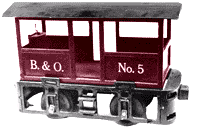 The Changing World of Commerce: Recently I attended an open house at the home of a toy train collector. On his layout was a 1903 loco - the only known 101 year-old Lionel train that still runs. Even the track is the original. It was obtained from the daughter of the original owner along with the 1903 bill of sale from the Emporium department store in San Francisco. In those days, Lionel was a start-up firm located in Lower Manhattan. The Changing World of Commerce: Recently I attended an open house at the home of a toy train collector. On his layout was a 1903 loco - the only known 101 year-old Lionel train that still runs. Even the track is the original. It was obtained from the daughter of the original owner along with the 1903 bill of sale from the Emporium department store in San Francisco. In those days, Lionel was a start-up firm located in Lower Manhattan.
It is difficult to imagine cross-country commerce in the very early 20th Century. Ordering was probably done strictly by mail; telephones were not in wide use and, in any case, there was no coast-to-coast long distance service. Bank wire transfers and credit cards were unheard-of. Mailed bank drafts and letters-of-credit were the primary means of money transfer. There would have been only two shipping options - rail shipment (expensive) or a cargo ship around Cape Horn (very slow). There was no Panama Canal yet. Offering, selling and delivering that little locomotive was a monumental effort by today's norms.
Yesterday, I ordered a model train. First, I e-mailed the manufacturer in North Carolina with some product questions; I received my answers within 24 hours. Then I e-mailed several retail hobby stores, requesting prices and delivery information on the item. A firm in Massachusetts responded with the best price, so I called their toll-free number and gave them my order. They checked availability on their computer database and gave me a shipping date. They asked only for my ZIP code; since I had purchased from them before, my address was already in their customer database. I paid with a Visa card; they entered the info into a terminal and got credit approval from Visa Merchant Services. I'm not in a hurry for the item but, if I was, it could easily be shipped by air and arrive within a day.
A 1903 purchaser would have been astounded by the details of my transaction. I wonder what things will be like 100 or so years from now? (posted 9/15/04, permalink)
Other Pages Of Interest
copyright 2004-15 - Joseph M. Sherlock - All applicable rights reserved
Disclaimer
The facts presented in this blog are based on my best guesses and my substantially faulty geezer memory. The opinions expressed herein are strictly those of the author and are protected by the U.S. Constitution. Probably.
Spelling, punctuation and syntax errors are cheerfully repaired when I find them; grudgingly fixed when you do.
If I have slandered any brands of automobiles, either expressly or inadvertently, they're most likely crap cars and deserve it. Automobile manufacturers should be aware that they always have the option of giving me free cars to try and change my mind.
If I have slandered any people or corporations in this blog, either expressly or inadvertently, they should buy me strong drinks (and an expensive meal) and try to prove to me that they're not the jerks I've portrayed them to be. If you're buying, I'm willing to listen.
Don't be shy - try a bribe. It might help.
| |

